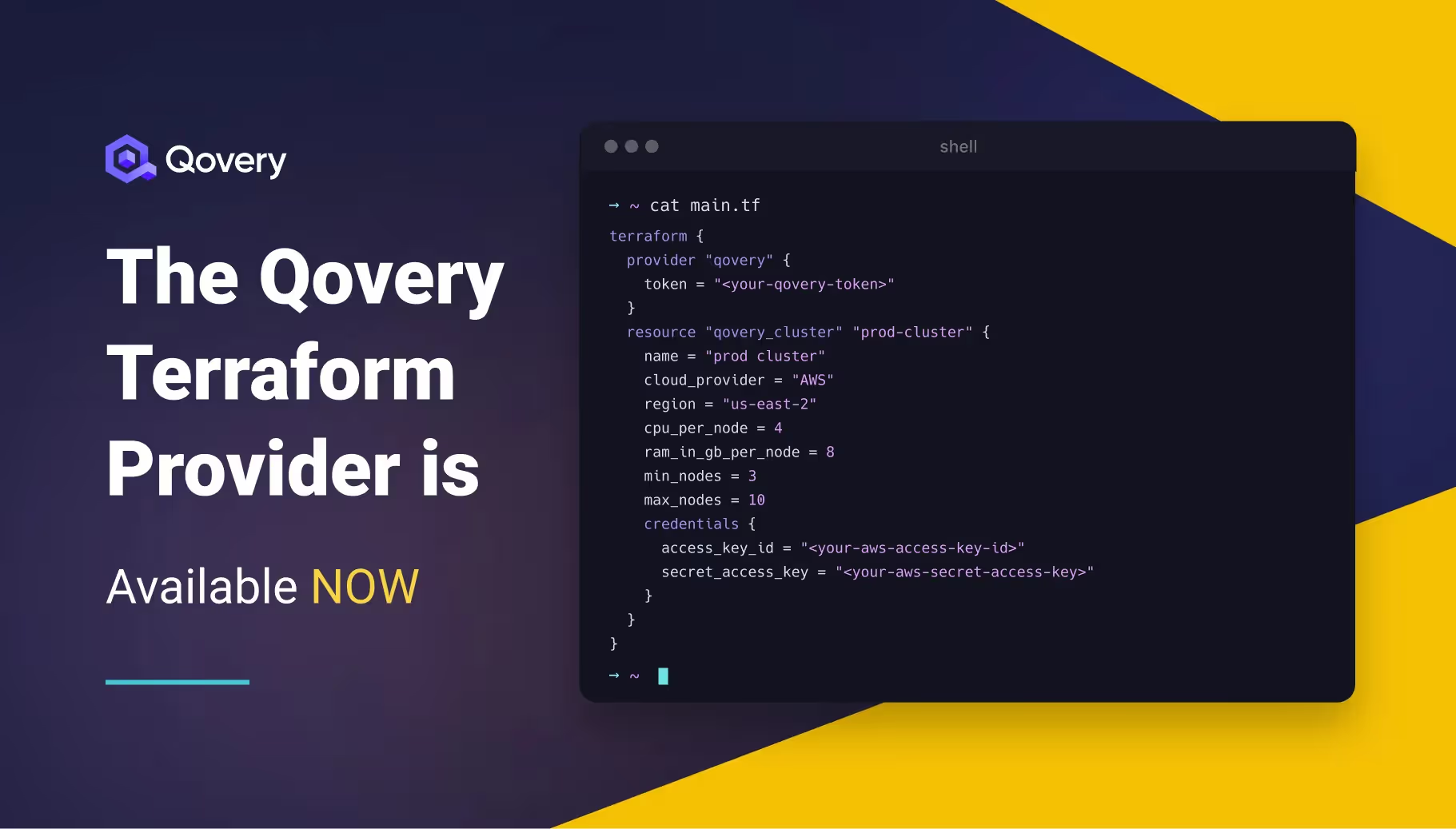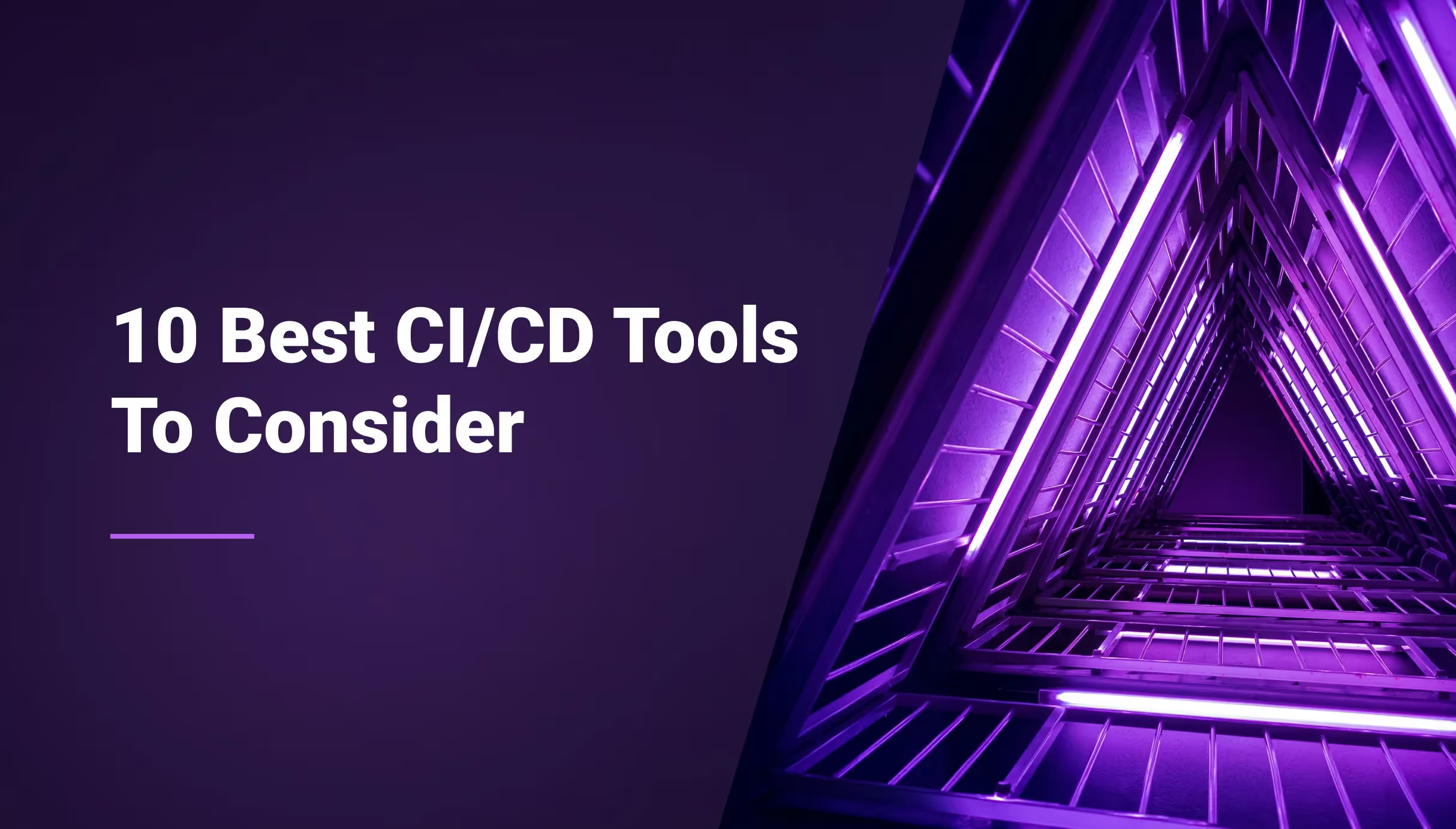What is Terraform
Terraform is an open-source infrastructure as code software tool created by HashiCorp. Thousands of products provide Terraform plugins (called providers) to manage them. Basically, you describe in a file how you want to configure your software and how you want to connect them, and Terraform manages everything for you. It is not magic. Thanks to the big Terraform community for providing and maintaining all the Terraform Providers. This is where the Qovery team provides and supports their Terraform Provider officially. Every contribution is appreciated.
Why should you use Terraform in the context of Qovery?
The main reason why using Terraform in the context of Qovery is to keep track of the changes across the configuration of your Qovery clusters, applications, and databases.
Demo
Watch our complete Terraform demo
Qovery Terraform Provider features
Create a Kubernetes cluster
AWS EKS cluster
Here is the Terraform configuration to create a Kubernetes cluster (EKS) on AWS.
terraform {
required_providers {
qovery = {
source = "qovery/qovery"
}
}
}
# Configure the Qovery provider
provider "qovery" {
token = ""
}
variable "organization_id" {
type = string
default = ""
}
resource "qovery_aws_credentials" "my_aws_creds" {
organization_id = var.organization_id
name = "my_aws_creds"
access_key_id = ""
secret_access_key = ""
}
resource "qovery_cluster" "my_cluster" {
organization_id = var.organization_id
credentials_id = qovery_aws_credentials.my_aws_creds.id
name = "test_terraform_provider"
description = "Kubernetes cluster created with Terraform"
cloud_provider = "AWS"
region = "us-east-2"
cpu = 2000 # 2000 mCPU = 2 vCPU
memory = 4096 # 4096 MB = 4GB
min_running_nodes = 3 # min auto scaling nodes
max_running_nodes = 10 # max auto scaling nodes
depends_on = [
qovery_aws_credentials.my_aws_creds
]
}Note: Qovery supports VPC configuration and static IPs for AWS EKS.
Scaleway Kapsule
Here is the Terraform configuration to create a Kubernetes cluster (Kapsule) on Scaleway.
terraform {
required_providers {
qovery = {
source = "qovery/qovery"
}
}
}
# Configure the Qovery provider
provider "qovery" {
token = ""
}
variable "organization_id" {
type = string
default = ""
}
resource "qovery_scaleway_credentials" "my_scaleway_creds" {
organization_id = var.organization_id
name = "my_scaleway_creds"
scaleway_access_key = ""
scaleway_secret_key = ""
scaleway_project_id = ""
}
resource "qovery_cluster" "my_cluster" {
organization_id = var.organization_id
credentials_id = qovery_scaleway_credentials.my_scaleway_creds.id
name = "test_terraform_provider"
description = "Kubernetes cluster created with Terraform"
cloud_provider = "SCALEWAY"
region = "fr-par-1"
cpu = 2000 # 2000 mCPU = 2 vCPU
memory = 4096 # 4096 MB = 4GB
min_running_nodes = 3 # min auto scaling nodes
max_running_nodes = 10 # max auto scaling nodes
depends_on = [
qovery_scaleway_credentials.my_scaleway_creds
]
}Digital Ocean Kubernetes
Here is the Terraform configuration to create a Kubernetes cluster on Digital Ocean.
terraform {
required_providers {
qovery = {
source = "qovery/qovery"
}
}
}
# Configure the Qovery provider
provider "qovery" {
token = ""
}
variable "organization_id" {
type = string
default = ""
}
resource "qovery_digitalocean_credentials" "my_digitalocean_creds" {
organization_id = var.organization_id
name = "my_digitalocean_creds"
token = ""
spaces_access_id = ""
spaces_secret_key = ""
}
resource "qovery_cluster" "my_cluster" {
organization_id = var.organization_id
credentials_id = qovery_digitalocean_credentials.my_digitalocean_creds.id
name = "test_terraform_provider"
description = "Kubernetes cluster created with Terraform"
cloud_provider = "DIGITAL_OCEAN"
region = "nyc3"
cpu = 2000 # 2000 mCPU = 2 vCPU
memory = 4096 # 4096 MB = 4GB
min_running_nodes = 3 # min auto scaling nodes
max_running_nodes = 10 # max auto scaling nodes
depends_on = [
qovery_digitalocean_credentials.my_digitalocean_creds
]
}Google Cloud Platform and Microsoft Azure?
We plan to support GCP and Azure this year. Check out our public roadmap.
Deploy an application
Here is a Terraform file to deploy an application in a Project and production Environment on my Kubernetes cluster via Qovery.
resource "qovery_project" "my_project" {
organization_id = var.organization_id
name = "MyProject"
}
resource "qovery_environment" "my_environment" {
project_id = qovery_project.my_project.id
name = "Production"
depends_on = [
qovery_project.my_project
]
}
resource "qovery_application" "my_backend_app" {
environment_id = qovery_environment.my_environment.id
name = "my backend app 1"
description = "My first app in my prod environment"
cpu = 500 # 500 mCPU = 0.5 vCPU
memory = 1024 # 1024 MB = 1GB
min_running_instances = 1 # min auto scaling app instances
max_running_instances = 3 # max auto scaling app instances
git_repository {
# you can set a private or public repository - Qovery manages it automatically for you
url = "https://github.com/evoxmusic/ShortMe-URL-Shortener"
branch = "main"
root_path = "/" change the root path for mono repositories
}
# Qovery provides a temporary domain and a TLS certificate auto-renew with CertManager
ports = [{
internal_port = 8080
external_port = 443
protocol = "HTTPS"
publicly_accessible = true
}]
depends_on = [
qovery_environment.my_environment
]
}Qovery provides tons of options to custom your application settings. Check out the app documentation or API to see all the capabilities.
Second application within the same environment
To add a second application (you can add more) within the same environment, it is as simple as adding a "qovery_application" object with a different name.
resource "qovery_application" "my_backend_app_2" {
environment_id = qovery_environment.my_environment.id
name = "my backend app 2"
description = "My first app in my prod environment"
# ... add other params
}Deploy a Postgres database
Qovery supports the deployment of Postgres in managed mode (with backups) and container mode (without backups). Check out the documentation to understand all the differences.
resource "qovery_database" "my_postgres" {
environment_id = qovery_environment.my_environment.id
name = "MyPostgres"
type = "POSTGRESQL"
version = "13"
mode = "CONTAINER" # and MANAGED
accessibility = "PRIVATE" # you can make your DB publicly accessible with PUBLIC
cpu = 250
memory = 256
storage = 10240 # in MB
depends_on = [
qovery_environment.my_environment
]
}Deploy a Redis database
Here is another example with Redis
resource "qovery_database" "my_redis" {
environment_id = qovery_environment.my_environment.id
name = "MyRedis"
type = "REDIS"
version = "6"
mode = "CONTAINER" # and MANAGED
accessibility = "PRIVATE" # you can make your DB publicly accessible with PUBLIC
cpu = 250
memory = 256
storage = 10240 # in MB
depends_on = [
qovery_environment.my_environment
]
}How to connect to a service not managed by Qovery?
Qovery's DevOps automation tool does not limit you. You can still connect to a service not managed by Qovery with VPC peering.
What else
Check out the exhaustive documentation to see all the capabilities. If something is missing, feel free to contribute by opening a Pull Request. Our Terraform provider uses our open API and our Golang SDK.
Wrapping up
Feel free to try out our Qovery Terraform Provider yourself and share your feedback on Discord and our forum.







.webp)



.svg)
.svg)
.svg)













